Calcrise. Battlefield, museum, ordinary horrors of the ancient war and a detective from 2000 years ago
Terrain
In 1988, a retired major in the British army, and now an amateur archaeologist, Tony Klann, discovered in the area of \uXNUMXb\uXNUMXbMount Kalkriese, not far from Osnabrück, a handful of coins and several almond-shaped objects. Upon further study, the latter turned out to be lead sling shells used in the Roman army.
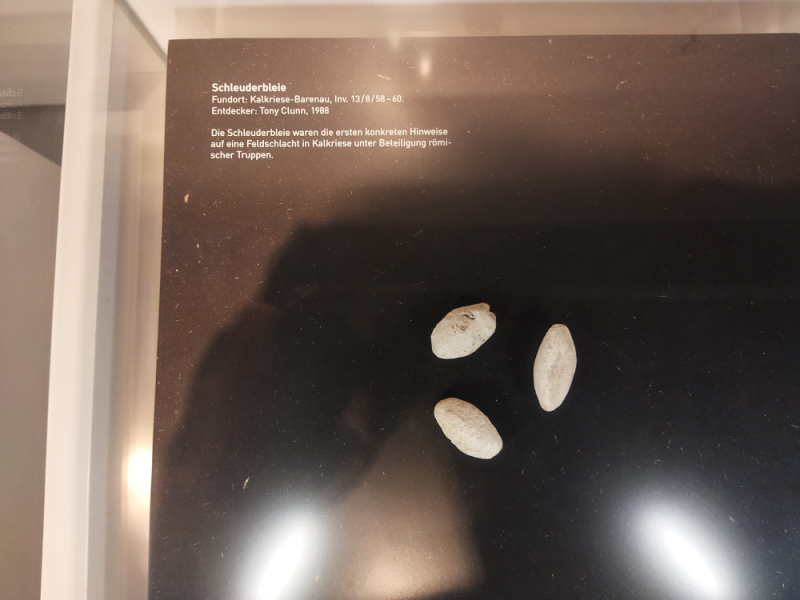
It all started with these inconspicuous pieces of metal. Varusshlacht Museum. Photo of the author.
This fact stirred the scientifichistorical community. The fact that the vicinity of Kalkriese could be the site of the battle in the Teutoburg Forest has been talked about for a very long time. In particular, the famous historian T. Mommsen adhered to this version. So far, however, searches have turned up nothing that could be connected to the battle of two thousand years ago, except for a certain amount of coins. And finally, the first find weapons.
Thus began a more than 30-year-old saga of excavations, which made it possible to shed light on many circumstances of the famous battle. Thousands of artifacts were found, including several unique ones, and the Varusschlacht Museum was built in Kalkriese to house them.
Time is merciless not only to people and the creations of their hands. Natural landscapes are also changing beyond recognition. Two thousand years ago, one kilometer north of the mountain, or rather the Kalkriese hill, was a huge swamp. Its swampy sections in some places approached the foot of the mountain, leaving a passage literally 100 meters wide, accessible to humans.
The slopes of Mount Kalkrize, due to the peculiarities of the relief, could retain water, forming flooded terraces. Even now, a lot of water accumulates on the slopes of the mountain. The situation was the same 2000 years ago. The fact that it rained during the battle is known to us from the description of the Roman historian Dion Cassius. For an army with a huge convoy, which also included the children and wives of legionnaires (this is also known from Cassius), even a low (110 m) mountain became an insurmountable obstacle.
Thus, the narrow strip of land between the northern slope and the swamp became an ideal place for an ambush. An army that finds itself in this region will be forced to climb into this natural bottleneck.
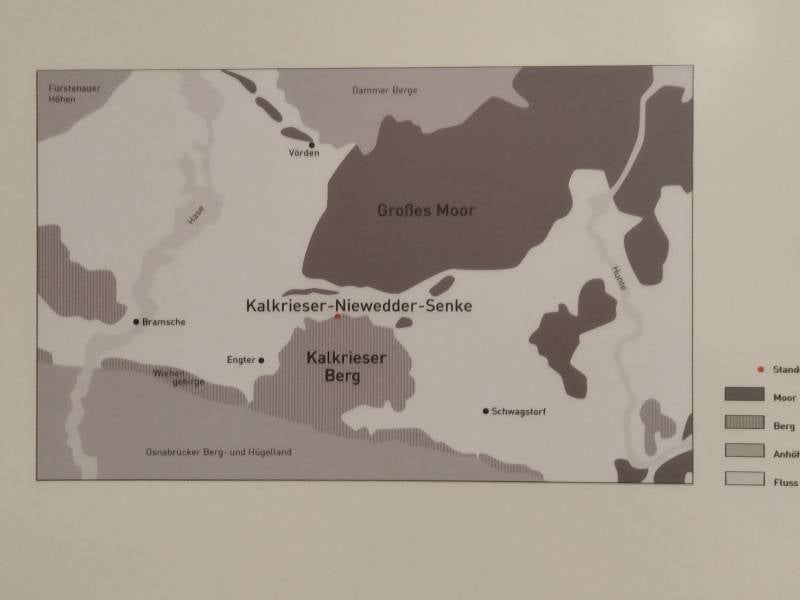
Reconstruction of the area. The Roman army marched from east to west. Varusshlacht Museum. Photo of the author.
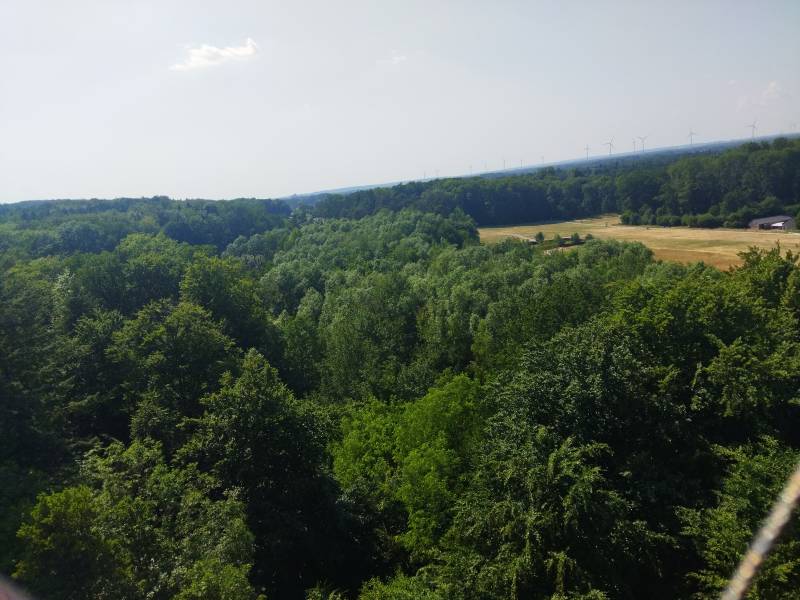
View of the northern slope of Mount Kalkrize. On the right (corresponding to the direction to the north), you can see the same passage and the fence of the archaeological site. The swamp, more precisely, the lowland in its modern form, is located even further to the north. Between the slope and the passage is a ravine overgrown with forest. Varusshlacht park. Photo of the author.
The reports of ancient authors about dense impenetrable forests in Germany in the case of Kalkriese are not confirmed. Palynological analysis of the finds showed pollen from plants of the goose foot, kochedyzhnik, bindweed, oats and peas species. The events were supposed to take place between July and September.
In 1992, a bell covered with plant remains was found in Kalkriza. Experts have identified, again, oats, peas, nomadic fern and chastukha. The last two plants are typical for swampy areas. Thus, the surroundings of the mountain were at least partially covered with agricultural crops already two thousand years ago, and the main obstacle was not the forests, but the swamps and water on the slopes mentioned above.
The area of Calcrise is reluctant to part with its prey. Acidic soils effectively dissolve organic matter. But in some places, limestones come to the surface, and then, with a bit of luck, archaeologists will find gloomy finds.
.
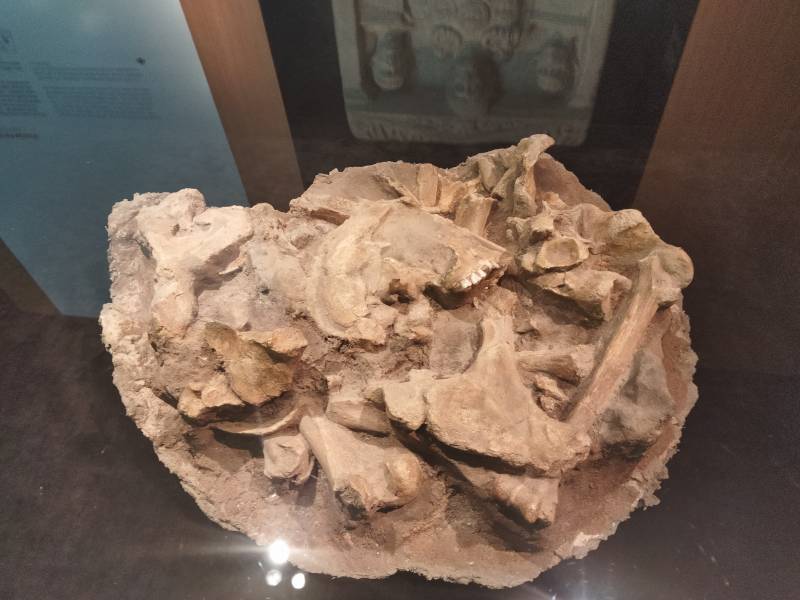
Fragment of a collective burial. In total, eight pits with remains were found. Photo of the author. Varusschlacht Museum
From the description of Tacitus, we know that the Roman soldiers of Germanicus, once at the site of the battle, arranged a collective burial of their fallen comrades.
Archaeologists supplement this evidence by indicating that such mass graves contained many bones belonging to the mules and horses of the defeated army. There are no complete skeletons, and the bones show bite marks and cracks, as if they had been lying on the surface for some time. Forensic medicine concludes that from the moment of death to burial, 3 to 10 years have passed. This is in full agreement with the news of Tacitus. Some fragments of bones found can be identified as female, presumably, they were the wives of legionnaires who shared the fate of the army.
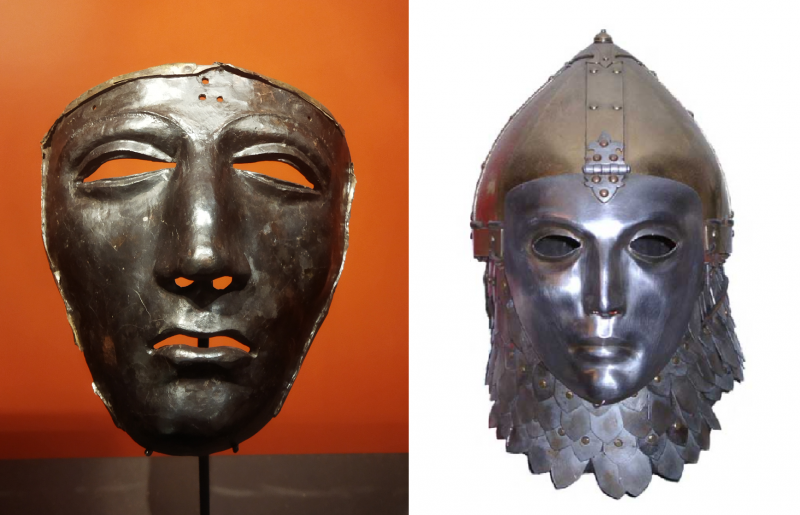
Left. Roman horseman mask. Calcrise. Visible holes for attaching to a helmet. Most researchers are inclined to believe that such masks were not combat, but rather ceremonial. Photo of the author. Varusschlacht Museum.
On right. Old Russian mask found in Izyaslavl. Reconstruction by P. A. Vasin. The author of the reconstruction believes that such masks go back to Roman models through Byzantine antiquities. Unlike their Roman counterparts, there is no doubt about their combat purpose - two well-known masks of this type were found in the layers of fires related to the Mongol pogrom. Quoted from: Vasin, Lemeshko "Lichiny"
Wall. Key Finding or Source of Misconceptions?
A big surprise was the discovery in 1990 of the remains of the shaft, not mentioned by ancient writers.
The shaft ran along the northern slope of Mount Kalkrize and stretched for 400 meters. Archaeologists believe that this rampart is the work of the Germans, not the Romans. Stretching from east to west, the shaft did not cut the defile between the mountain and the swamp across, as one might think, but for some reason was extended parallel to the alleged movement of the Romans.
Perhaps the attackers wanted to further narrow the passage in this way, or strengthened the mountainside, which looked more accessible, or even arranged a “golden bridge” for the enemy, suggesting that the Romans abandon everything and rush into the passage while they bombard them with projectiles with impunity for almost half a kilometer. The estimated height of the shaft is 4 m. Dark spots in the soil layer indicate that a wattle fence probably passed along the top.
As already mentioned, the soil around is not conducive to the preservation of organic matter. However, bodies eaten by the earth leave behind deposits of phosphates. As a result, the soil acquires a pale yellow color, and if there are especially many phosphates, it becomes bright orange. Near the shaft, the samples show an increased content of phosphates.
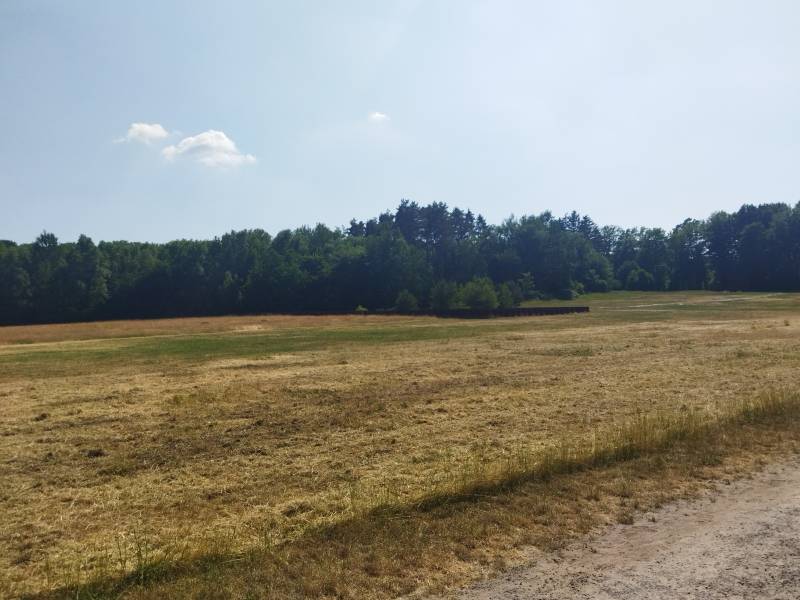
View of the wall, or rather, the place where it was, from the north (from the side of the former large swamp). The northern slope of the mountain begins behind the wall. It can be seen that the mountain practically does not rise above the forest. The ground in front of the wall is leveled, but this is the result of the activities of the peasants, who have been cutting the sod for many years, and erosion. Two thousand years ago, the surface here was very bumpy. The fence was erected around the sites of archaeological excavations. Photo of the author. Park Varusschlacht
So, the discovery of the rampart seems to support the version of an ambush in a narrow defile. In this form, our story managed to get into the pages of books and articles devoted to the battle.
However, archeology does not stand still.
Control drilling in the Kalkrize park adjacent to the wall revealed the remains of v-shaped ditches to the north, east and west of the wall. A characteristic profile, fortifications on at least three sides, is that really it? The Roman camp, the last refuge of the legions of Varus!
According to the new interpretation, the Roman army not only entered the bottleneck at the foot of the mountain, but also set up camp there. The "Germanic" wall, apparently, was built before the battle and ended up right on the territory of the Roman camp. Next to it was something like a manor.
It's hard to say what exactly happened next. It turns out that the camp was well located, covered from the north by a swamp, and from the south by a mountain with water barriers and fortified according to all the rules. Nevertheless, it was taken by the Germans, as evidenced by the finds of mass graves. Yes, there is still a huge amount of work to be done.
Another oddity is connected with the shaft.
Finds of Roman equipment at the excavation site are generally rare, as if the victorious Germans went through everything very carefully in search of valuables. However, in the area of the rampart, the concentration of Roman weapons is unexpectedly even anomalously high. Remains of helmets, shield umbos, spearheads, cloak fasteners were found.
Does this mean that after the battle the shaft became an exhibition of the trophies of the victors? We know that the Greeks set up a tropion of taken weapons and armor at the place of victory. The Romans did the same, for example, Germanicus placed trophies in the German lands at least twice. Did the Germans themselves have something similar?
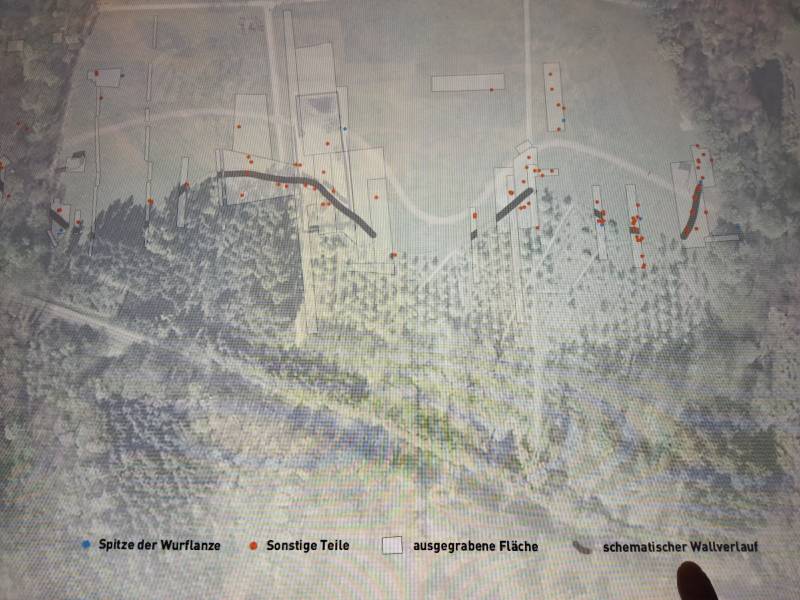
It can be seen how the finds gravitate towards the area of the rampart. On both sides of the rampart, Germanic pottery is found in abundance. As for the German equipment, only two items were found, but even their attribution is ambiguous. Photo of the author. Varusschlacht Museum
Cold case - an antique capercaillie and an exhibition of the same name at the Varusschlachtmuseum
In 2018, during excavations in the area of the rampart, a metal detector produced a particularly strong signal. A fragment weighing several hundred kilograms was cut out of the ground and sent for detailed study to the Fraunhofer Institute.
For almost two years, layer by layer, archaeologists and specialists from the institute's laboratory have been extracting finds.
Their eyes were presented with an iron chain three meters long and elements of armor of a high degree of preservation. Near the find at the excavation site, a pilum, a Roman amulet, and something else were found.
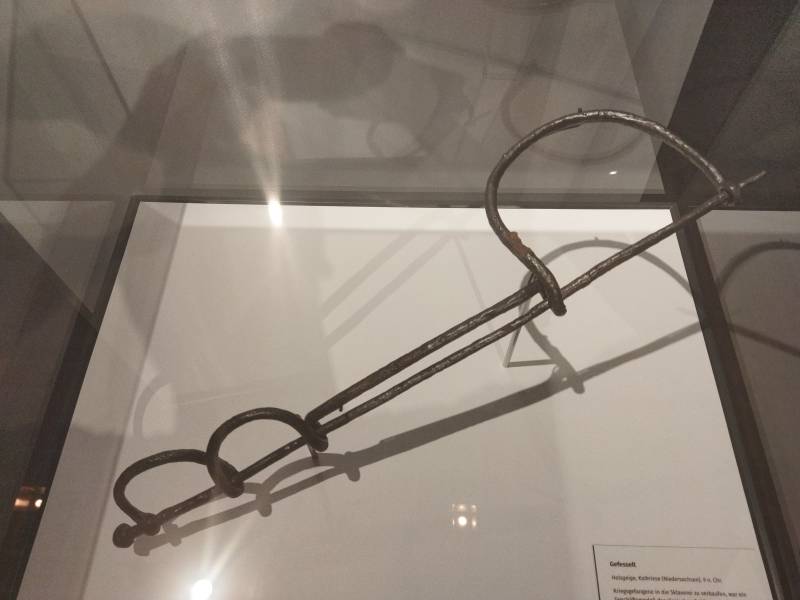
Roman iron fetters for captives. A large loop is for the neck, two small loops are for the wrists. After imposing fetters on the neck and arms, a rod was inserted into the eyes of the device and fixed with something like a cotter pin at the back. Varusschlacht Museum. Author's photo
Long iron chain, Roman armor, metal fetters for prisoners. What actually happened here?
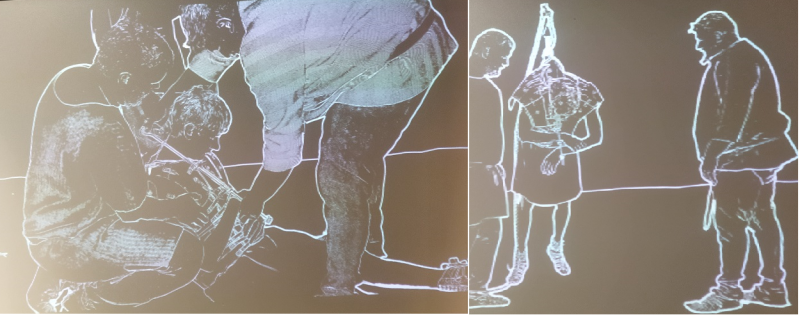
Reconstruction of events. A Roman soldier, still alive or dead, is put on a Roman fetter - a retainer, and hung up with a chain. It is possible that armor straps were used for hanging. Varusschlacht Museum. Author's photo
It is difficult to say whether this was a form of sacrifice or whether the unfortunate man was simply hung as a trophy. Probably a living trophy, otherwise why would you need metal fetters. Tacitus speaks of the sacrificed captives:
And mentions the hanged, but without details:
And what about the armor?

And here he is. The oldest lorica segmentata and even in the best condition. The weight of the reconstructed armor is 10 kg. Varusschlacht Museum. Author's photo
What else?
The Cold case exhibition is not limited to the exhibits found at Calcrise. A retrospective of laminar armor is given, starting with a replica of Dendra's armor. And to illustrate the horrors of the war, the organizers compiled an anthology of finds at the sites of other mass graves.
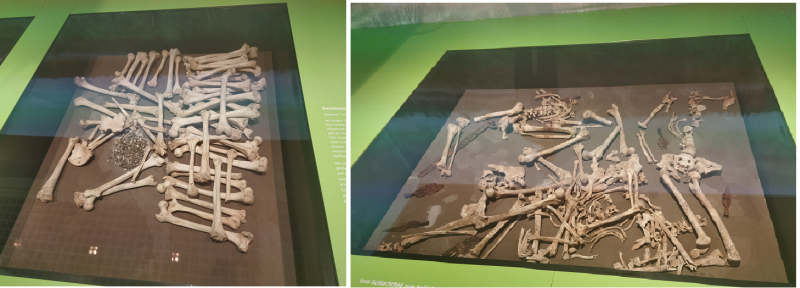
Mass grave from Ribemont-sur-Ancre, where the remains of hundreds of men aged between 20 and 40 were found. In the third century BC, one of the Gallic tribes defeated its neighbors. The bones of the arms and legs of approximately 350 people were laid out in a square. The rest of the bones were destroyed. Nearby was a mass grave for about 100 people. Their skeletons were practically intact, but the skulls were missing. Roman authors reported that the heads of enemies were a valuable trophy among the Celts. Somme Patrimoine specially for the Cold case exhibition. Varusschlacht Museum. Author's photo
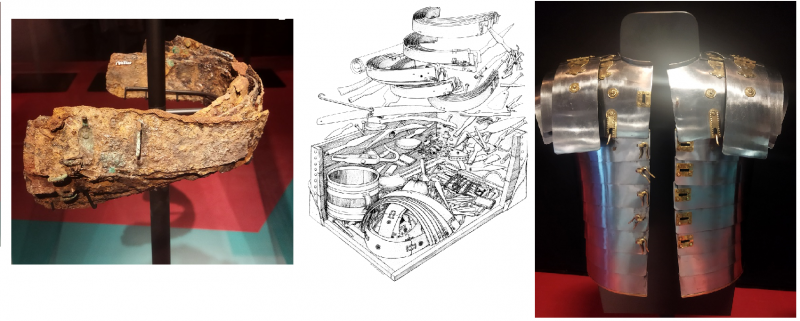
From left to right. Fragments of a segmentata from Corbridge. English Heritage Trust for the Cold case exhibition.
Reconstruction of the find from Corbridge according to P. Connolly.
Armor reconstruction based on finds from Corbridge.
Varusschlacht Museum. Author's photo
Fragments of Lorica segmentata from Corbridge are presented. Dated between 122 and 138. n. e. The so-called "Corbridge hoard" contained parts of 12 segmentata, as well as blacksmith's tools. For some reason, the Romans left the permanent camp in a hurry. Lorica segmentata from Corbridge had wider, and therefore more reliable loops and simpler protection in the shoulder area. Despite the progress, it was still a very complex armor. So, the legion master in Corbridge incorrectly assembled the plates on his back.
The fact that the Germans had their own rite of displaying trophies can be evidenced by the remains of laminar armor from Stilfried presented at the exhibition. During the period of the Marcomannic wars, the Roman outpost was captured, and the armor, presumably, was fixed for viewing.
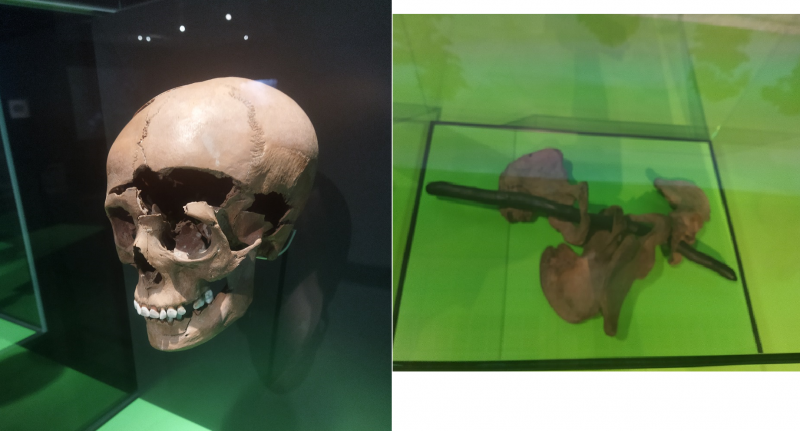
Left. Female skull found in the region of Regensburg. In the third century A.D. e. the Roman villa was attacked by enemies. Thirteen of the inhabitants had their heads broken. The woman was also scalped. The bodies were thrown into the well along with household items. Historical Museum Regensburg especially for the Cold case exhibition.
On right. The area of Alken Enge in the north of Denmark in the first century BC. e. became the scene of bloody showdowns of the Germanic tribes. Nearly 400 men fell in the battle. Many were killed from the back - while fleeing or lying face down on the ground. Their bodies were still lying there. But a year later, people came to the battlefield again. They broke some of the corpses lengthwise, boiled the bones and carefully sorted them. The photo shows the remains of the pelvic bones that belonged to four men. Four halves strung on a branch, strictly alternating left and right sides. Then the result of such labors was drowned in the lake. Skanderborg Museum for the Cold case exhibition. Varusschlacht Museum. Photo of the author.
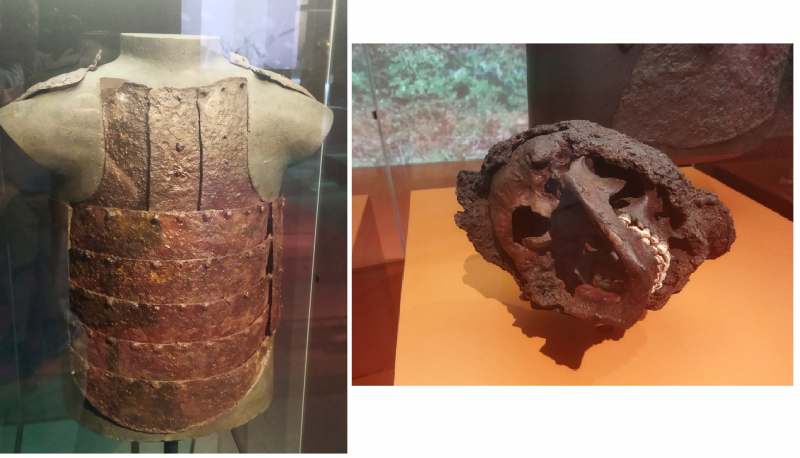
Left. Brigantine from the burial of Visby. It bears some resemblance to ancient segmentates: large laminar plates protect the lower part of the body. Rivets fastening to the outer layer of fabric or leather are visible, in contrast to the segmentate, where a set of plates was fixed by rows of straps from the inside.
On right. Head, apparently severed, despite the chainmail hood. Visby burial ground. Stockholm Historical Museum for Cold case exhibition, Varusschlacht Museum. Photo of the author.
In 1361, the inhabitants of Gotland were defeated by the troops of the Danish king. The remains of 800 people, 25 plate armor, three bracers, 200 chain mail were found in mass graves. For some reason, the armor did not interest the winners. Perhaps due to intense decomposition (the battle was in the middle of summer) or simply such armor was already considered obsolete then. Finds from Sweden are also presented at the exhibition.
Conclusion. About the benefits of legends
The battle in the Teutoburg Forest became a kind of hallmark of the German people back in the days of the Habsburgs. The battle was widely used for propaganda purposes, glorified the valor of the Germans and served as a kind of manifesto about the importance of unification. Over time, when the propaganda husks fell off, there was a place for revisionist ideas.
Skeptics rightly pointed out that the success did not save the Germans from further campaigns of the Romans, that Germanicus took revenge in the battle of Idistaviso, and that the Germans could not repeat such a success for a very long time. However, this often forgets the moral aspect of the victory, which gave a powerful impetus to further resistance. In addition, the loss by Rome of the territory between the Rhine and the Elbe, which, as it seemed, was about to become another province, is quite obvious.
In order to get even with the Germans, Germanicus brought 15 legions in 8, and at least 16 in 12. The legions were supported by numerous auxilia and a river fleet. Another fleet operated in the North Sea. But even this was not enough to conquer the Zarein regions.
What a striking contrast with the conquest of Gaul, when 8 (initially 4 in general) legions of Caesar literally crushed the resistance of the Gauls. Perhaps it was the great success and the heroic legend associated with it that the Gauls did not have enough to defend their independence (the similar victory of Ambiorix was many times more modest). As for the conqueror of the Romans, Arminius, Tacitus wrote that the Germans sang this name in his time, that is, three generations later.
Information